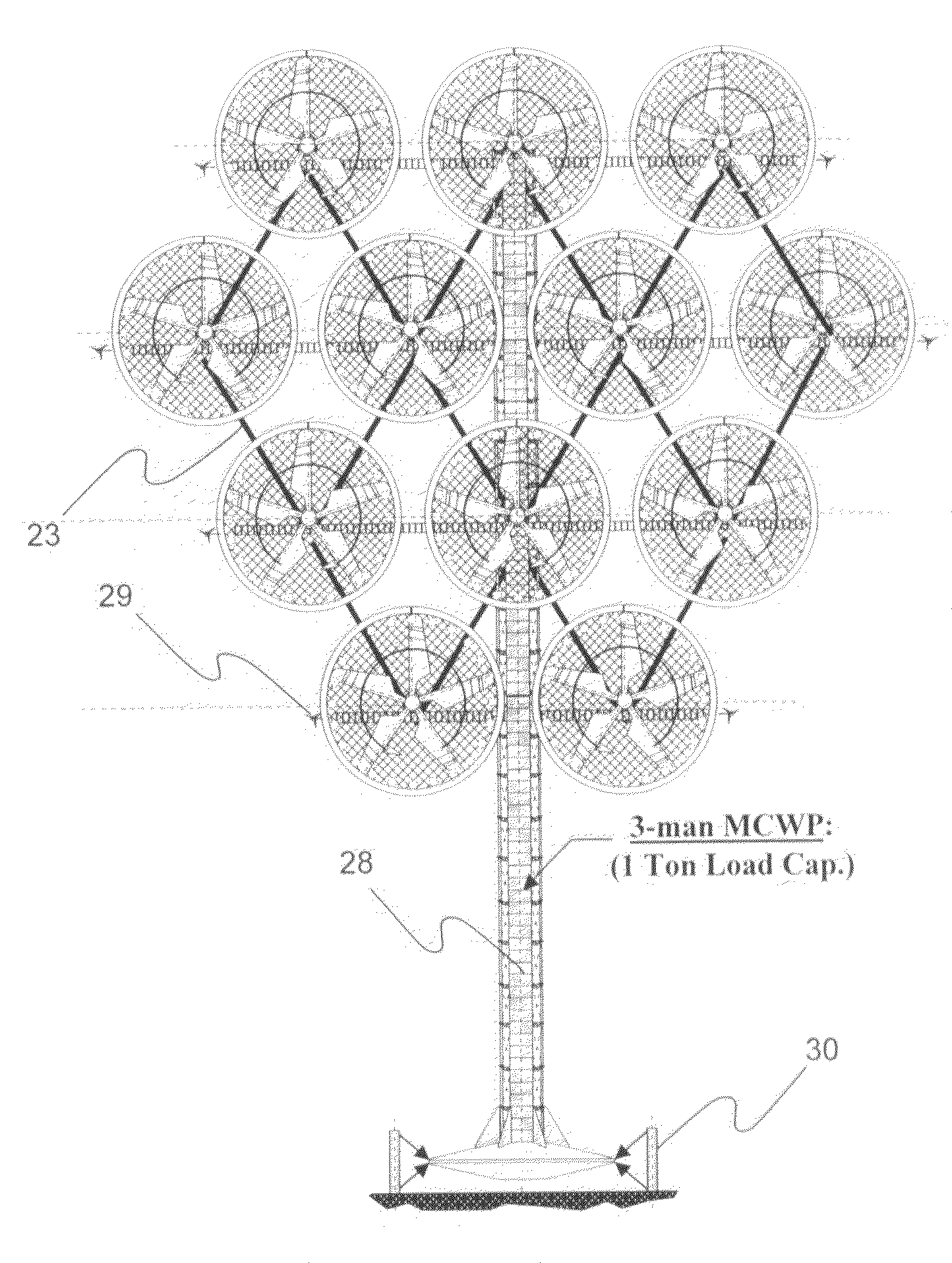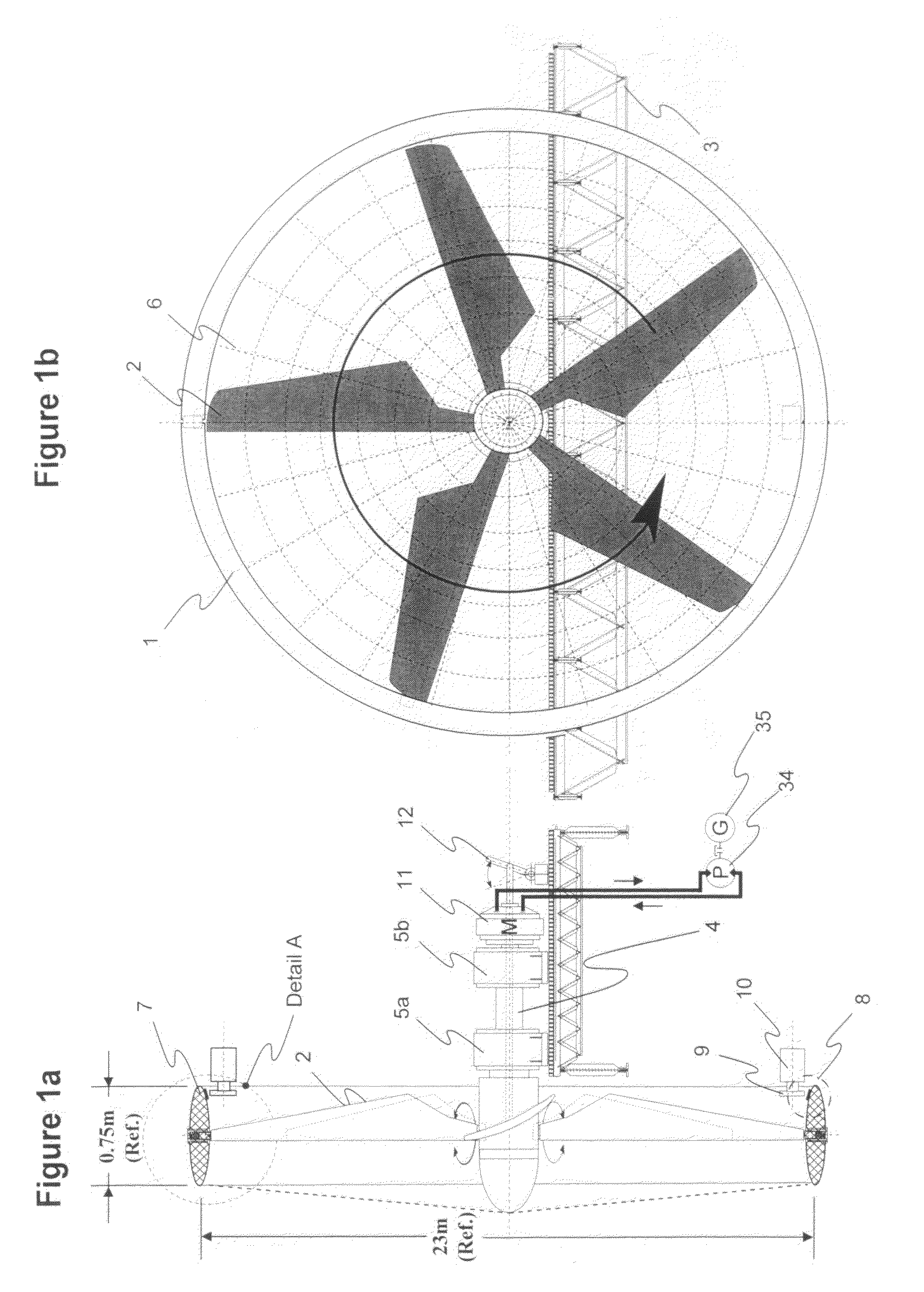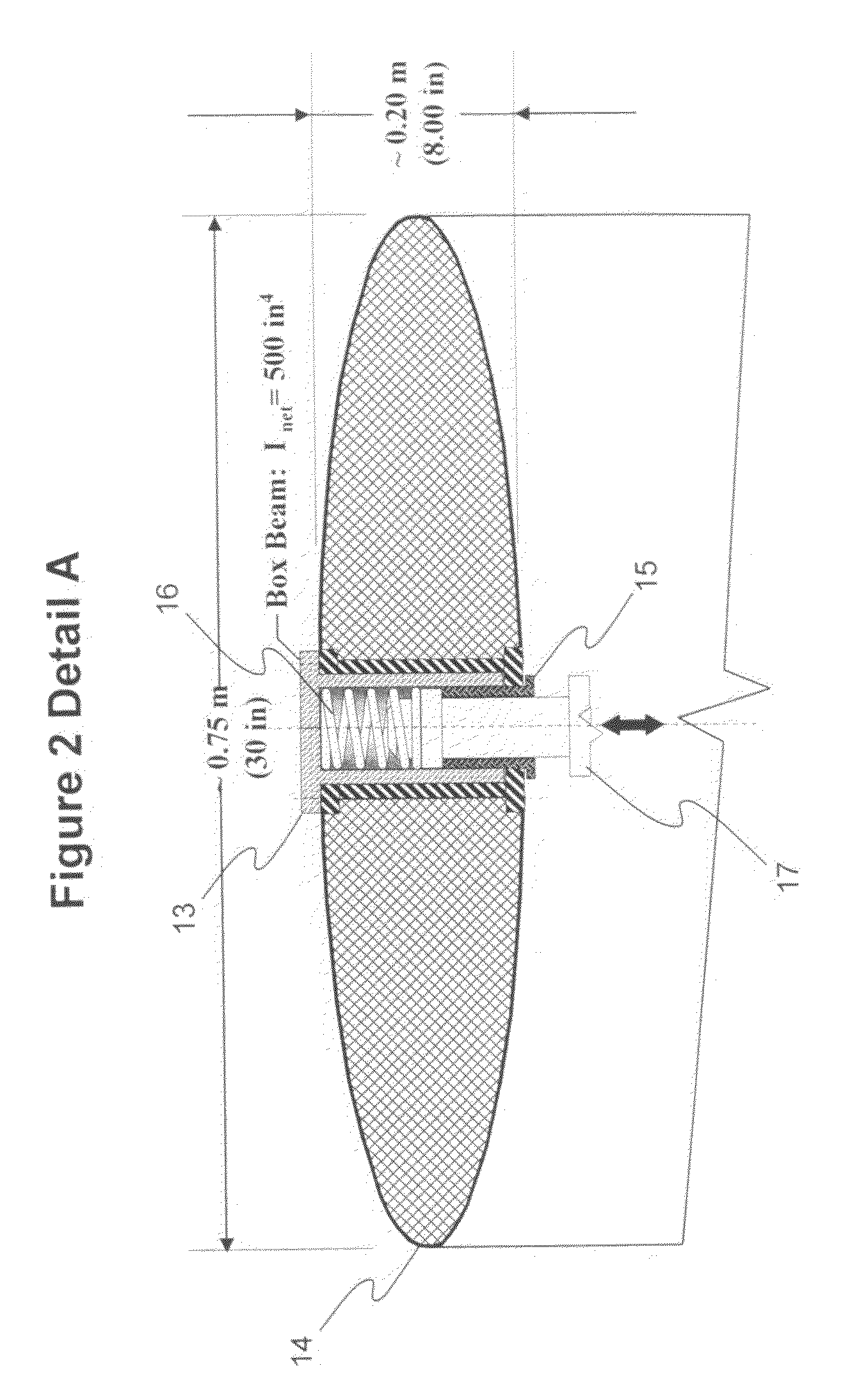Unfortunately, this practice assumes that energy is being uniformly extracted over the entire swept area.
It is evident that wind velocities remain essentially unchanged as they pass through the inner 70% of the rotor disc of conventional wind turbines, causing large flow-field discontinuities downstream.
This ratio is usually low, because a sufficiently strong blade cannot be created to
resist the induced bending without a large
section modulus.
A large
section modulus requires thick blade sections, typically 25% to 35% of the chord dimension, generating excessive drag.
The logistical and infrastructure required to move such large assemblies to remote wind farms demands
high load capacity roadways for the transport vehicles and constitutes a major Balance of
Station cost for new installations.
Also, the logistical
impact with respect to
traffic congestion in the site of the wind farm is severe, with up to 120 one-way trips for material and equipment per MW of installed capacity.
This complexity, coupled with little or no structural damping (<3% hysteretic), makes them highly susceptible to blade / rotor interactions with the
tower structure, potentially leading to
multiple modes of forced vibratory response.
Near-
resonance exciting forces can drive the rotor blades into large displacement amplitudes that can lead to
catastrophic failure from excessive bending stresses.
HAWT rotor blades, weighing up to 30 or more tons, are extremely complex, and expensive tooling of their composite materials contributes to their high cost of fabrication.
They are susceptible to catastrophic over-speeding in high wind conditions, resulting in serial failure in their redundant
pitch controlled furling, blade tip air brakes, and / or main shaft braking systems.
Additional catastrophic, life-threatening, failures occur when
stress fractures result in to thrown blades, generating massive imbalance, leading to destruction of the component elements within the
nacelle, and ultimately to blade
impact with the steel
tower and its
resultant destruction.
The power
takeoff point from the rotor main shaft is very difficult to access for performing maintenance and repair operations.
Both the gearboxes and the generators are highly susceptible to expensive and time-consuming failures, typically occurring within the first 2-to-3 years.
The inability of the Industry to achieve theoretical lifetime goals of 20 years or more for gearbox reliability is forcing a number of wind turbine manufacturers to look at alternative approaches, such as direct-coupled
low speed permanent
magnet generator configurations.
Unrealized goals for
mean time between failures, mandating warranty periods limited to 1-2 years, and high operating and maintenance costs for gearboxes, are directly traceable to gear teeth or bearing failures caused by unexpected overload conditions, and / or failure of the
lubrication system.
Existing HAWT gearbox designs are manufactured to the highest precision levels (AGMA class 12 and 13), requiring expensive tooling and time-consuming manufacturing processes to meet the design tolerances.
Although this process noticeably improves the operating efficiency of the gearbox in the relatively short time of 24 hours, once the particles are generated, they immediately initiate micro-pitting and accelerated wear.
The gearboxes are
highly sensitive to loss of
lubricity at temperatures above 180° F., causing the accumulation of gum and
varnish, accelerating
tooth wear and the buildup of backlash, and increasing failure from sudden overload conditions.
The result is catastrophic tooth failure.
Unfortunately, this safety factor is not nearly sufficient to cope with the highly variable and very large imposed loads being transmitted into the gearbox by the rotor assemblies, which is a primary causal mechanism for inducing gearbox failures.
This constant bending fluctuation leads to a very large number of cumulative fatigue cycles in a very short time.
Providing a sound
mechanical design for this overload condition is a formidable challenge, and appears to be one of the most likely reasons that a large number of wind turbines are laying idle, awaiting repair.
Obviously, the bird kill potential for these prior art designs is also quite high.
The turbulent eddy and swirl of these prior art HAWT designs exacerbate both the downwind and
crosswind effects of adjacent wind turbine assemblies, and induce higher levels of discontinuity to the incident wind of the partially shaded adjacent downwind and
crosswind turbines.
It is a well-known phenomenon that both downwind and
crosswind turbines are less reliable than the front row lead turbines in a large wind farm.
The low reliability of gears, blades, bearings and generators makes it difficult to offer more than a one-year warranty, generates large warranty payments caused by failed components, and creates substantial
downtime and inability to meet mean-time-to-repair (MTTR) expectations.
Many systems cannot operate in a cost effective manner in less than US DOE / National
Renewable Energy Laboratory Class 4 wind conditions (˜5.8 m / sec ref 10 m elevation).
Additionally, purchases of new wind turbines declines rapidly without the availability of subsidized support from the federally-mandated Production Tax Credit (˜1.9¢ / kWh).
Finally, profitable operation is not generally possible, even in Class 4 winds, without Investment Tax Credits and allowances for Double Declining Depreciation and amortization schedules of up to 30 years.
Existing prior art wind turbines suffer from a number of liabilities other than their exceptionally poor efficiency, poor economics, and serious reliability problems.
They include both audible
noise level generation and inaudible infrasonic noise, which can travel for many miles; unsightliness and obstruction of view from the towers, rotor blade
flicker; and the kill-rate of birds and bats.
For these reasons, a prevailing “Not In My Back
Yard” (NIMBY) set of objections make the permitting processes for gaining wind farm site acceptance a generally long and arduous affair.
 Login to View More
Login to View More  Login to View More
Login to View More 


